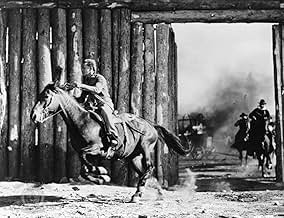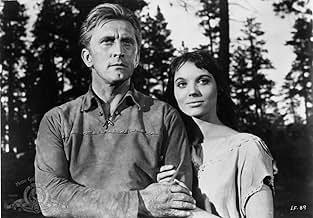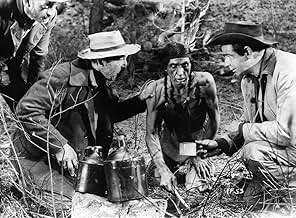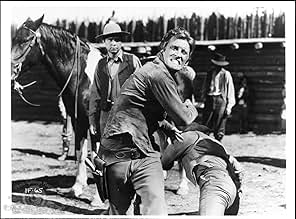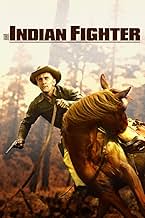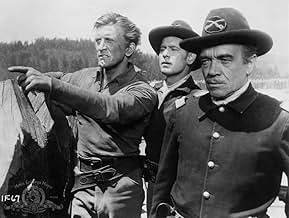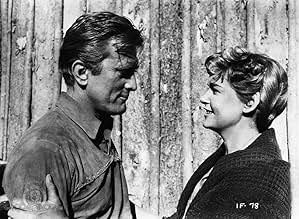CALIFICACIÓN DE IMDb
6.3/10
3 k
TU CALIFICACIÓN
Un explorador que conduce una caravana a través del hostil territorio indio se involucra sin querer con la hija de un jefe Sioux.Un explorador que conduce una caravana a través del hostil territorio indio se involucra sin querer con la hija de un jefe Sioux.Un explorador que conduce una caravana a través del hostil territorio indio se involucra sin querer con la hija de un jefe Sioux.
- Dirección
- Guionistas
- Elenco
Lon Chaney Jr.
- Chivington
- (as Lon Chaney)
Alan Hale Jr.
- Will Crabtree
- (as Alan Hale)
Elisha Cook Jr.
- Briggs
- (as Elisha Cook)
Lane Chandler
- Head Settler
- (sin créditos)
Robert 'Buzz' Henry
- Lt. Shaeffer
- (sin créditos)
- Dirección
- Guionistas
- Todo el elenco y el equipo
- Producción, taquilla y más en IMDbPro
Opiniones destacadas
Kirk Douglas is portrayed as a lovable jack-the-lad here, always ready to fight for right. He's got a winning quip, a twinkle in his eye and a heart of a lion. I beg to differ.
For starters, right at the beginning he sees an Indian squaw he likes, taking a bath in a lake. So what does he do? Forget about roses or chocolates... he virtually ASSAULTS her to get a kiss, and then steals her knife into the bargain. Later on, he does the exact same thing. Guess what... this brutish behaviour actually makes her FALL IN LOVE with the maniac, and she has sex with him in the forest (only implied though... this WAS made in 1955 after all). This infatuation also causes him to divert a wagon train of white folk on a two day detour from their destination into hostile Indian territory... just so he can sneak a peek at her. This leads to a huge fight, in which many lives are lost on both sides. Some 'hero'.
If you ignore the movie's celebration of this psycho, and the dubious underlying message that we should all resort to Stone Age methods to get the girl of our dreams, there is quite a bit to enjoy here. Full scale battles, majestic cinematography, a compelling story, the works. There are amusing supporting characters, including a young guy who wants to photograph the whole Wild West with his newfangled invention known as a 'camera', and a tough widow with a little boy who is constantly proposed to by a boring fertiliser-obsessed farmer. Sadly for him, her affections (which remain unrequited) lie with Kirk Douglas... and even more bafflingly, her son idolises this lunatic too. Suddenly, soil is starting to seem more appealing by the minute...
So, yeah. Not a classic, but a rousing enough spectacle. With a protagonist I love to hate. Next... 6/10
For starters, right at the beginning he sees an Indian squaw he likes, taking a bath in a lake. So what does he do? Forget about roses or chocolates... he virtually ASSAULTS her to get a kiss, and then steals her knife into the bargain. Later on, he does the exact same thing. Guess what... this brutish behaviour actually makes her FALL IN LOVE with the maniac, and she has sex with him in the forest (only implied though... this WAS made in 1955 after all). This infatuation also causes him to divert a wagon train of white folk on a two day detour from their destination into hostile Indian territory... just so he can sneak a peek at her. This leads to a huge fight, in which many lives are lost on both sides. Some 'hero'.
If you ignore the movie's celebration of this psycho, and the dubious underlying message that we should all resort to Stone Age methods to get the girl of our dreams, there is quite a bit to enjoy here. Full scale battles, majestic cinematography, a compelling story, the works. There are amusing supporting characters, including a young guy who wants to photograph the whole Wild West with his newfangled invention known as a 'camera', and a tough widow with a little boy who is constantly proposed to by a boring fertiliser-obsessed farmer. Sadly for him, her affections (which remain unrequited) lie with Kirk Douglas... and even more bafflingly, her son idolises this lunatic too. Suddenly, soil is starting to seem more appealing by the minute...
So, yeah. Not a classic, but a rousing enough spectacle. With a protagonist I love to hate. Next... 6/10
"The Indian Fighter" was filmed entirely in the outdoor beauty of Oregon. The scenery and color are breathtaking. The action scenes are expertly staged and executed, particularly the Indian attack on the fort.
Kirk Douglas stars in the title role as a scout who is hired to guide a wagon train through Indian Territory to Oregon. Walter Matthau (in an early role) and Lon Chaney (wasted again) play the villains of the piece who start up an Indian war by trying to steal gold from their land. Eduard Franz plays Red Cloud the Sioux chief who tries to keep the white man from encroaching on his people's land.
Elsa Martinelli is an Indian maiden who becomes Douglas' main love interest and Diana Douglas (Kirk's wife at the time and mother of MIchael) plays a settler woman with designs on Kirk but who has to settle for hard-working Alan Hale instead. I wonder how Diana Douglas felt about Kirk rolling around in a creek with Ms. Martinelli?
Rounding out the cast are a number of familiar faces. Walter Abel plays the army captain, Elisha Cook a frontier photographer and Ray Teal, Frank Cady and Lane Chandler as various settlers.
"The Indian Fighter" rises a step above similar westerns through its beautiful scenery and exciting action sequences. It is a truly exciting and colorful outdoor adventure.
Kirk Douglas stars in the title role as a scout who is hired to guide a wagon train through Indian Territory to Oregon. Walter Matthau (in an early role) and Lon Chaney (wasted again) play the villains of the piece who start up an Indian war by trying to steal gold from their land. Eduard Franz plays Red Cloud the Sioux chief who tries to keep the white man from encroaching on his people's land.
Elsa Martinelli is an Indian maiden who becomes Douglas' main love interest and Diana Douglas (Kirk's wife at the time and mother of MIchael) plays a settler woman with designs on Kirk but who has to settle for hard-working Alan Hale instead. I wonder how Diana Douglas felt about Kirk rolling around in a creek with Ms. Martinelli?
Rounding out the cast are a number of familiar faces. Walter Abel plays the army captain, Elisha Cook a frontier photographer and Ray Teal, Frank Cady and Lane Chandler as various settlers.
"The Indian Fighter" rises a step above similar westerns through its beautiful scenery and exciting action sequences. It is a truly exciting and colorful outdoor adventure.
At the heart of De Toth's oeuvre lies an interesting contradiction. He has an abiding interest in suspense, action, and the wellspring of violent events (a fact underlined by the number of thrillers, frontier yarns and dramas he helmed during his career), but, as a director, characteristically disassociates himself from their process. This 'distancing' effect has been noted by a number of viewers, creating some critical debate about De Toth's engagement with his material. In my view his detachment is not to be confused with aloofness - an interesting comparison can be made with Stanley Kubrick's alleged 'coldness' - but is rather De Toth's way of resolving what really 'matters'. It is this intelligence, revealing itself sharply in his best films, that makes him such a worthwhile study.
Along with De Toth's assured debut 'Ramrod' (1947) and the austere 'Day of the Outlaw' (1959), 'The Indian Fighter' is probably the finest of his Western films, revealing a characteristic response to the demands of the genre. In 'Ramrod' the moral questing springs from a noirish plot that is unsettled and full of tension. In 'Day of the Outlaw' issues are resolved more formally, played out against the stark landscape of Winter. In 'The Indian Fighter', De Toth's concerns manifest themselves in his most lyrical and sensuous work. He thereby creates a film which, in emphasis, is in direct contrast to most other 50's Westerns.
This is ostensibly a tale of a famous frontiersman Johnny Hawks (played with usual lusty gusto by Kirk Douglas), back from the wars. Ultimately he has to redeem his reputation, discovering balance within the indigenous people he has previously warred against. Gold has been discovered on Indian land, and the bad guys (a marvellous performance by Walter Matthau, ably supported by Lon Chaney, Jnr) are out to kill and cheat to secure the riches. This, and the related fear of a tribal uprising, provide the main action point of the film.
As the Indian fighter of the title, ironically the first thing we notice about Hawks is his reticence. In fact he hardly fights at all - only when he is obliged, or when called upon to at the climax of the film. For him, combat is not a prerequisite, although he is not slow to react when needs be. A comparison with the bitterness of Ethan Edwards, say, in Ford's 'The Searchers' is revealing. Edwards loathes the Commanches, with a bitterness entirely absence from De Toth's hero. As Hawks' opponents observe, he is more of an Indian lover than fighter. And, of course, in the most obvious way, they are right. Almost more important to the hero than his professional reputation is his preoccupation with the Indian maid Onhati. His single-minded pursuit, and later dalliance, with her initiates the main crisis of the film, as he leaves the wagon train to be by her side, after taking it 'two days out of my way and half way up a mountain'.
This is a film full of sensuality, placed in contrast to 'duty', the calling of action. We are constantly reminded of the cool pools, green foliage, closeness of the earth, just as much as of the teachery and turmoil of the frontier. Franz Waxman's score is lyrical and evocative, frequently idyllic. The glorious cinematography gives nature's perpetual garden a pantheistic gloss, sometimes intense, and always resplendent. Just as the main film captures these images, so in mimicry does Briggs, a supposed protégé of civil war photographer Matthew Brady, who frequently accompanies Hawks. He is eager to capture the grandeur around him. His camera is as significant to us as it is to Hawks, who makes a point of rescuing it at one point (during the battle at the fort). An important minor character, Briggs emphasises the appreciation of the sublime and beautiful that the film invites. A couple of times De Toth pauses the action (once at the fort and then at the wagon train), to pan his camera for long seconds along sets and people, recording their place in the Oregon landscape. Like Briggs he wants to admire, and record.
A circular film, 'The Indian Fighter' begins with Hawks gazing at Onhati bathing naked in a pool. It ends with him joining her in the water, forming a happy couple. The whole world of action is thus enclosed by their bonding, their sensual preoccupation usurping the violent demands of Indian-white conflict.
The scenes between the two lovers caused a murmur at the time. Considered 'risque' for the conservative 50's Western, De Toth simply inserted them, and their sexual self-absorption, as entirely fitting his plan of things. What is more eyebrow-raising today is how he allowed the encounters between two lovers to backstage the expected intrigues of masculine action, and actually assume greater significance, reversing regular audience expectations. This stress, an essentially feminine one. is completely uncharacteristic of the Western at this time. Add to that a sympathetic view of Indians and nature conservation (the Indian Chief's environmental concerns are a main reason for his refusing to exploit the land with mining) and you have an excellent film - a career highlight of this greatly underrated director.
Along with De Toth's assured debut 'Ramrod' (1947) and the austere 'Day of the Outlaw' (1959), 'The Indian Fighter' is probably the finest of his Western films, revealing a characteristic response to the demands of the genre. In 'Ramrod' the moral questing springs from a noirish plot that is unsettled and full of tension. In 'Day of the Outlaw' issues are resolved more formally, played out against the stark landscape of Winter. In 'The Indian Fighter', De Toth's concerns manifest themselves in his most lyrical and sensuous work. He thereby creates a film which, in emphasis, is in direct contrast to most other 50's Westerns.
This is ostensibly a tale of a famous frontiersman Johnny Hawks (played with usual lusty gusto by Kirk Douglas), back from the wars. Ultimately he has to redeem his reputation, discovering balance within the indigenous people he has previously warred against. Gold has been discovered on Indian land, and the bad guys (a marvellous performance by Walter Matthau, ably supported by Lon Chaney, Jnr) are out to kill and cheat to secure the riches. This, and the related fear of a tribal uprising, provide the main action point of the film.
As the Indian fighter of the title, ironically the first thing we notice about Hawks is his reticence. In fact he hardly fights at all - only when he is obliged, or when called upon to at the climax of the film. For him, combat is not a prerequisite, although he is not slow to react when needs be. A comparison with the bitterness of Ethan Edwards, say, in Ford's 'The Searchers' is revealing. Edwards loathes the Commanches, with a bitterness entirely absence from De Toth's hero. As Hawks' opponents observe, he is more of an Indian lover than fighter. And, of course, in the most obvious way, they are right. Almost more important to the hero than his professional reputation is his preoccupation with the Indian maid Onhati. His single-minded pursuit, and later dalliance, with her initiates the main crisis of the film, as he leaves the wagon train to be by her side, after taking it 'two days out of my way and half way up a mountain'.
This is a film full of sensuality, placed in contrast to 'duty', the calling of action. We are constantly reminded of the cool pools, green foliage, closeness of the earth, just as much as of the teachery and turmoil of the frontier. Franz Waxman's score is lyrical and evocative, frequently idyllic. The glorious cinematography gives nature's perpetual garden a pantheistic gloss, sometimes intense, and always resplendent. Just as the main film captures these images, so in mimicry does Briggs, a supposed protégé of civil war photographer Matthew Brady, who frequently accompanies Hawks. He is eager to capture the grandeur around him. His camera is as significant to us as it is to Hawks, who makes a point of rescuing it at one point (during the battle at the fort). An important minor character, Briggs emphasises the appreciation of the sublime and beautiful that the film invites. A couple of times De Toth pauses the action (once at the fort and then at the wagon train), to pan his camera for long seconds along sets and people, recording their place in the Oregon landscape. Like Briggs he wants to admire, and record.
A circular film, 'The Indian Fighter' begins with Hawks gazing at Onhati bathing naked in a pool. It ends with him joining her in the water, forming a happy couple. The whole world of action is thus enclosed by their bonding, their sensual preoccupation usurping the violent demands of Indian-white conflict.
The scenes between the two lovers caused a murmur at the time. Considered 'risque' for the conservative 50's Western, De Toth simply inserted them, and their sexual self-absorption, as entirely fitting his plan of things. What is more eyebrow-raising today is how he allowed the encounters between two lovers to backstage the expected intrigues of masculine action, and actually assume greater significance, reversing regular audience expectations. This stress, an essentially feminine one. is completely uncharacteristic of the Western at this time. Add to that a sympathetic view of Indians and nature conservation (the Indian Chief's environmental concerns are a main reason for his refusing to exploit the land with mining) and you have an excellent film - a career highlight of this greatly underrated director.
While far from perfect, it handled the Indians in a way far more credibly than most films of the day
With a title like THE Indian FIGHTER, you'd think that this was the standard "let's kill all the Indians" type movie so typical in the 1940s and 50s. However, like some of the better cowboy and Indian films of the era (such as the great FORT APACHE and the not so great CHEYENNE), the reason for the Indians hating the Whites is explained--they are not just unreasoning savages or idiots, but people justifiably angry at their mistreatment by the invading Whites. Because of this, I appreciated the film and was also happy that it also wasn't like some of the newer breed of films that paint the Indians and completely noble and the Whites as the epitome of evil! It did seem well balanced AND featured mostly Indians in Indian parts (though, oddly, they chose an Italian lady to play the female leading Indian!).
The rest of the film, while entertaining and having the usual great performance by Kirk Douglas, also is very simplistic and poorly thought out at times. For example, the motivation for why Douglas saved Walter Mathau's sorry butt at the beginning of the film is unclear. It defied common sense not to just let the Indians kill Mathau. Plus, at the end of the film, Douglas' confrontation with Douglas and Lon Chaney, Jr. was a long time coming but was resolved awfully quickly--making it seem very anti-climactic. Still, overall it does stand out from the HUGE number of look alike Westerns and it is worth your time.
The rest of the film, while entertaining and having the usual great performance by Kirk Douglas, also is very simplistic and poorly thought out at times. For example, the motivation for why Douglas saved Walter Mathau's sorry butt at the beginning of the film is unclear. It defied common sense not to just let the Indians kill Mathau. Plus, at the end of the film, Douglas' confrontation with Douglas and Lon Chaney, Jr. was a long time coming but was resolved awfully quickly--making it seem very anti-climactic. Still, overall it does stand out from the HUGE number of look alike Westerns and it is worth your time.
I had noticed this video for rent several times, but had always thought that the cover photo showed Kirk Douglas with Natalie Wood. Much to my surprise, it turns out not to be Natalie at all, but someone far more unusual, Elsa Martinelli, someone it seems I know best as Charlton Heston's love interest in "The Pigeon That Took Rome", the slim but pleasant comedy from 1962.
In fact, this film is "introducing Elsa Martinelli", a fresh import from Italy at the time. Bell' Italia indeed. Elsa introduces herself to us in the opening scene by undressing completely to go for a quiet dip in the river. So it's going to be la dolce vita along the riverbank, it seems...
As the beautiful long-haired Indian maiden, Elsa finds herself teamed with Kirk, brandishing his chin and his triangular physique. The Wild West lives up to its name, not only with the Indians' fiery attack on the army fort, the film's climax, but also with the steamy roll in the "surf" by our two principals, a couple of years after "From Here to Eternity".
The film offers Elisha Cook an unusual part to play, a photographer who had worked with Matthew Brady during the War, and who now wants to immortalize the West with his camera as advertising to attract settlers. The film understands the dichotomy of preservation and destruction that his character represents.
Walter Matthau and Lon Chaney are the bad white men, while Alan Hale (Gilligan's Skipper) and Frank Cady (Green Acres' Mr. Drucker) round out a nostalgic supporting cast.
Produced by Kirk Douglas's own production company, Bryna, "The Indian Fighter" can't help but have a social conscience. It does show the strong influence of the message Western -- in its interracial romance, Cook's proto-Ansel Adams character, and so on -- but without sacrificing the adventure elements of the story.
The film boasts some spectacular Oregon scenery. It's not the Monument Valley desert landscape we're used to seeing in so many other epic Westerns when directed by John Ford, but rather mountainous and riverine terrain, more like what Ford showed us in "How the West Was Won" (1962).
André De Toth provides good solid Cinemascope direction, letting the widescreen process work its own wonders on the audience. The film however does betray more brutality than I would have expected, especially for its day.
All in all, an adventure story intelligently and attractively handled, with some depth for those who care to look.
In fact, this film is "introducing Elsa Martinelli", a fresh import from Italy at the time. Bell' Italia indeed. Elsa introduces herself to us in the opening scene by undressing completely to go for a quiet dip in the river. So it's going to be la dolce vita along the riverbank, it seems...
As the beautiful long-haired Indian maiden, Elsa finds herself teamed with Kirk, brandishing his chin and his triangular physique. The Wild West lives up to its name, not only with the Indians' fiery attack on the army fort, the film's climax, but also with the steamy roll in the "surf" by our two principals, a couple of years after "From Here to Eternity".
The film offers Elisha Cook an unusual part to play, a photographer who had worked with Matthew Brady during the War, and who now wants to immortalize the West with his camera as advertising to attract settlers. The film understands the dichotomy of preservation and destruction that his character represents.
Walter Matthau and Lon Chaney are the bad white men, while Alan Hale (Gilligan's Skipper) and Frank Cady (Green Acres' Mr. Drucker) round out a nostalgic supporting cast.
Produced by Kirk Douglas's own production company, Bryna, "The Indian Fighter" can't help but have a social conscience. It does show the strong influence of the message Western -- in its interracial romance, Cook's proto-Ansel Adams character, and so on -- but without sacrificing the adventure elements of the story.
The film boasts some spectacular Oregon scenery. It's not the Monument Valley desert landscape we're used to seeing in so many other epic Westerns when directed by John Ford, but rather mountainous and riverine terrain, more like what Ford showed us in "How the West Was Won" (1962).
André De Toth provides good solid Cinemascope direction, letting the widescreen process work its own wonders on the audience. The film however does betray more brutality than I would have expected, especially for its day.
All in all, an adventure story intelligently and attractively handled, with some depth for those who care to look.
¿Sabías que…?
- TriviaKirk Douglas did most of his own horseback riding and, at one point, broke his nose attempting a stunt that called for him to make his horse fall. Instead of leaning back in the saddle when yanking the horse's head around to the side, Douglas leaned forward and took the full force of the horse's heavy head right in the face. Bill Williams was Douglas' stunt double, and "was an excellent rider [he was later killed doing a stunt for Cómo casi se perdió el oeste (1965)], and in silhouette looked a lot like me."
- ErroresRight before the Indians tie Todd to the tree with the intention of burning him, he's having a conversation with Johnny. During this conversation, Johnny's left arm repeatedly changes positions, from being stretched out against the tree, to holding his hat in front of him and back to stretched out against the tree.
- Citas
Grey Wolf: There can be no friendship between Red Man and White. The fight is to the end. Ride back to your people. There is no room for you here.
Johnny Hawks: You've grown a big mouth since I saw you last, Grey Wolf, but I didn't come here to talk to a big mouth. I've come to talk to a big man.
- ConexionesReferenced in Los desconocidos de siempre (1958)
Selecciones populares
Inicia sesión para calificar y agrega a la lista de videos para obtener recomendaciones personalizadas
- How long is The Indian Fighter?Con tecnología de Alexa
Detalles
Taquilla
- Total en EE. UU. y Canadá
- USD 2,450,000
- Tiempo de ejecución1 hora 28 minutos
- Relación de aspecto
- 2.35 : 1
Contribuir a esta página
Sugiere una edición o agrega el contenido que falta

Principales brechas de datos
By what name was A un paso de la muerte (1955) officially released in India in Hindi?
Responda

